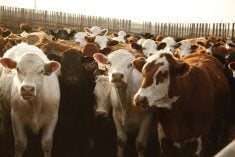International trade was relatively easy for sheep and goats going into breeding flocks in the United States before BSE was found in Canada.
Now, the lack of a full scrapie surveillance and eradication program has lost Canada that lucrative trade, says veterinarian Lynn Tait.
Canada has developed new markets for semen and embryos since 2003, but they do not come close to the former trade.
As well, many countries still prefer live animals over frozen genetics because they require technical expertise to be used successfully.
Read Also

Growth plates are instrumental in shaping a horse’s life
Young horse training plans and workloads must match their skeletal development. Failing to plan around growth plates can create lifelong physical problems.
“Those markets have a long way to go before they can even come close to having the economic impact of having U.S.-Canada borders open,” Tait told the cross border animal health committee that met as part of the Pacific Northwest Economic Region summit held in Calgary July 19.
Small ruminants could move freely across the Canadian-U. S. border tests for American breeding stock to show they did not have brucellosis, tuberculosis or bluetongue.
“It was a fairly open border and there was a huge trade in live animals,” said Tait, who represented the Canadian Livestock Genetics Association. “There is some movement of breeding stock into Canada, but there is no movement of breeding stock going south.”
The U.S. Department of Agriculture needs to write legislation before trade can resume.
Small ruminants were excluded when rules were written to permit live cattle and bison into the country.
Feeder and slaughter animals younger than 12 months are allowed, but no animals have been exported.
Last year, Canada imported 33,000 slaughter and feeder lambs to British Columbia, Alberta and Ontario to fill domestic demand.
Canada also had a good market to Mexico and the Caribbean, which bought live breeding goats and sheep.
However, the U.S. will not allow Canadian breeding stock to cross American soil in transit to Mexico or the Caribbean, and those countries do not want to pay for air freight.
Kathleen Parker, an Alberta lamb producer and veterinarian from Three Hills, said Canada and the U.S. need scrapie surveillance programs that complement each other and comply with internationally recognized health regulations.
“We have not had a lot of uptake on the scrapie surveillance program by our producers,” she said.
Animals are examined at abattoirs for scrapie and BSE to establish a disease prevalence rate. No BSE has been found.
More producer education is needed. “I’m not sure they fully understand
what doors are closing to them,” Parker said.
Canadian sheep inv tories are also down, and fewer ewes means fewer lambs are available to supply the domestic market.
Canadian Sheep Federation manager Jennifer MacTavish said more than half the lamb eaten in Canada is imported from Australia and New Zealand.
Canada slaughtered 742,000 lambs last year, including imports, which is down from 775,000 lambs slaughtered in 2004. In 2008, 37 million kilograms of lamb were consumed in Canada, but only 18 million kg were produced domestically.















